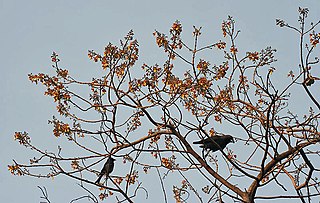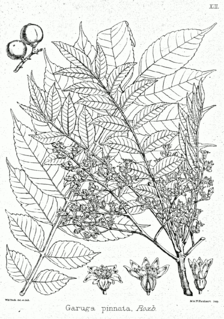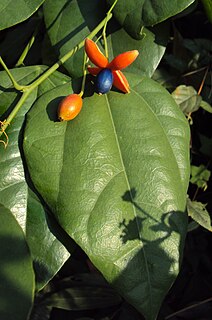
Taeniasis is an infection within the intestines by adult tapeworms belonging to the genus Taenia. There are generally no or only mild symptoms. Symptoms may occasionally include weight loss or abdominal pain. Segments of tapeworm may be seen in the stool. Complications of pork tapeworm may include cysticercosis.

Heritiera is a genus of flowering plants in the family Malvaceae, subfamily Sterculioideae. They are most dominant tropical forest trees in several areas in eastern Africa and India to the Pacific. Some are mangroves. Several are valuable for their timber and are over-exploited.

Gmelina is a genus of plants in the family Lamiaceae. It consists of about 35 species in Australia, New Guinea, New Caledonia, Southeast Asia, India and a few in Africa. Some species such as G. arborea have been planted and/or become naturalised in India, Africa and Australia. It was named by Carl Linnaeus in honour of botanist Johann Georg Gmelin.
Paranephelium is a genus of Asian small trees in family Sapindaceae, subfamily Sapindoideae.

Woodfordia fruticosa is a species of plant in the family Lythraceae.
Taenia asiatica, commonly known as Asian taenia or Asian tapeworm, is a parasitic tapeworm of humans and pigs. It is one of the three species of Taenia infecting humans and causes taeniasis. Discovered only in 1980s from Taiwan and other East Asian countries as an unusual species, it is so notoriously similar to Taenia saginata, the beef tapeworm, that it was for a time regarded as a slightly different strain. But anomaly arose as the tapeworm is not of cattle origin, but of pigs. Morphological details also showed significant variations, such as presence of rostellar hooks, shorter body, and fewer body segments. The scientific name designated was then Asian T. saginata. But the taxonomic consensus turns out to be that it is a unique species. It was in 1993 that two Korean parasitologists, Keeseon S. Eom and Han Jong Rim, provided the biological bases for classifying it into a separate species. The use of mitochondrial genome sequence and molecular phylogeny in the late 2000s established the taxonomic status.

Capparis zeylanica is a climbing shrub common in the forests of the Indian subcontinent, Indo-China, China and Malesia; no subspecies are listed in the Catalogue of Life. Several species of Lepidopteran larvae feed on its leaves.

Garuga pinnata is a deciduous tree species from the family Burseraceae.
Scutigera asiatica is a centipede species in the family Scutigeridae.
Ryania is a genus of plants in the family Salicaceae; it was previously listed in the now defunct family Flacourtiaceae.

Austracris is a genus of Orthoptera: Caeliferan insect in the family Acrididae: subfamily Cyrtacanthacridinae. It includes an Australian pest, the spur-throated locust.

Protium serratum is a small-medium tree species in the genus Protium and the family Burseraceae. The Catalogue of Life does not record any subspecies.

Trichosanthes tricuspidata is a climbing plant in the family Cucurbitaceae.

Pothos scandens is a climbing tropical forest plant in the family Araceae. It is the type species of the genus Pothos. No subspecies are recorded in the Catalogue of Life.
Strobilanthes involucrata is a species of flowering plants in the family Acanthaceae and the tribe Ruellieae. It is found in south-east Asia: native to Java and introduced to Indo-China. This was previously considered a species of the monotypic genus Pachystrobilus.
Skwala is a genus of springflies in the family Perlodidae. There are about five described species in Skwala.

Gmelina philippensis is a plant species in the family Lamiaceae. No subspecies are listed in the Catalogue of Life.
Metarhizium rileyi is a species of entomopathogenic fungus in the family Clavicipitaceae; there is extensive literature under its synonym Nomuraea rileyi.
Notothixos is a genus of mistletoe plant in the family Santalaceae.

Erythropalum is a monotypic genus containing the species Erythropalum scandens and currently placed in Erythropalaceae section of the family Olacaceae. Its native range is India and S. China and Indo-China to Malesia, with no subspecies listed in the Catalogue of Life. Its name in Vietnamese is dây hương.
















